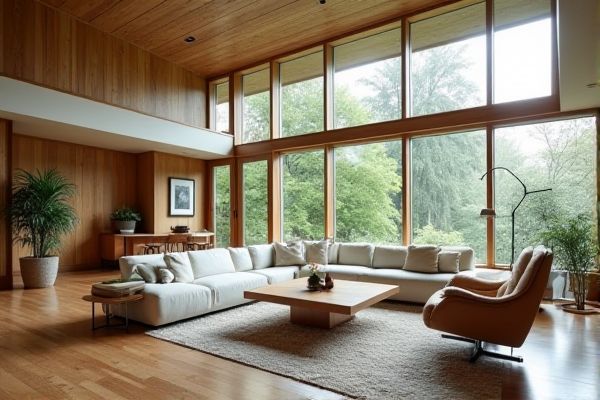
Floor-to-ceiling windows maximize natural light and offer expansive outdoor views, creating a seamless connection between indoor and outdoor spaces. Discover which window style best suits Your home's design and functionality by exploring the detailed comparison ahead.
Table of Comparison
| Feature | Floor-to-Ceiling Windows | Half-Wall Windows |
|---|---|---|
| Coverage | Full height, from floor to ceiling | Half-height, usually from floor to mid-wall |
| Natural Light | Maximum natural light influx | Moderate natural light |
| Views | Unobstructed panoramic views | Partial views with lower perspective |
| Privacy | Low privacy, requires treatments | Higher privacy, less exposure |
| Energy Efficiency | Potential heat loss/gain, needs high-quality glazing | Better insulation potential |
| Cost | Higher installation and material costs | Lower cost and simpler installation |
| Architectural Impact | Modern, sleek, open-space appearance | Traditional or transitional style |
Introduction to Floor-to-Ceiling vs Half-Wall Windows
Floor-to-ceiling windows maximize natural light and provide expansive outdoor views, enhancing interior spaces with a sleek, modern aesthetic. Half-wall windows offer privacy and wall space for furniture placement while still allowing natural light to enter, making them ideal for cozy or functional rooms. Choosing between floor-to-ceiling and half-wall windows depends on design goals, spatial needs, and desired interaction with the exterior environment.
Defining Floor-to-Ceiling Windows
Floor-to-ceiling windows are large, uninterrupted glass panes that extend from the floor to the ceiling, maximizing natural light and offering expansive outdoor views. These windows enhance interior aesthetics by creating a seamless connection between indoor and outdoor spaces, often used in modern homes and commercial buildings. Compared to half-wall windows, floor-to-ceiling designs provide greater illumination and a more open feel while contributing to energy efficiency through advanced glazing technologies.
Understanding Half-Wall Windows
Half-wall windows, also known as partial-height windows, are installed at mid-wall level, allowing for both natural light and privacy while maintaining space for furniture or wall decor below. Unlike floor-to-ceiling windows, half-wall windows provide a balance between external views and interior wall space, making them ideal for rooms where privacy or wall functionality is important. These windows enhance ventilation and daylight without compromising structural integrity or creating excessive heat loss.
Aesthetic Appeal: Modern vs Traditional Designs
Floor-to-ceiling windows create a sleek, contemporary aesthetic by maximizing natural light and offering unobstructed outdoor views, ideal for modern architectural styles. Half-wall windows contribute to a more traditional design by providing a balanced blend of wall space and window area, complementing classic interior layouts and adding a cozy ambiance. You can elevate your home's visual appeal by choosing window styles that align with either modern minimalism or traditional charm based on your design preferences.
Natural Light and Room Illumination
Floor-to-ceiling windows maximize natural light by allowing unobstructed sunlight to enter, significantly enhancing room illumination throughout the day. Half-wall windows provide moderate natural light while maintaining wall space for furniture placement and privacy. The choice impacts light distribution: floor-to-ceiling windows create a brighter, more open atmosphere, whereas half-wall windows offer balanced illumination with structural advantages.
Energy Efficiency and Insulation Performance
Floor-to-ceiling windows often provide less insulation and lower energy efficiency compared to half-wall windows due to their larger glass surface area, which can lead to greater heat loss in winter and heat gain in summer. Half-wall windows typically incorporate more wall space, allowing for better insulation materials and reducing thermal transfer, thereby enhancing your home's overall energy performance. Choosing half-wall windows can improve insulation, lower energy bills, and maintain a more consistent indoor temperature.
Privacy Considerations
Floor-to-ceiling windows provide expansive views and natural light but may compromise your privacy, especially in urban settings or close neighbors. Half-wall windows offer a balance by allowing light while maintaining privacy through the lower solid wall section. Choosing between these options depends on your need for natural light versus the priority you place on privacy in your living space.
Installation Costs and Long-Term Value
Floor-to-ceiling windows generally have higher installation costs due to the need for reinforced structural support and specialized glazing, which can increase upfront investment significantly. Half-wall windows offer a more budget-friendly option with easier installation, but may lack the expansive sunlight and view benefits that enhance property value. Choosing floor-to-ceiling windows can maximize your home's long-term value through improved aesthetics and natural lighting, despite the initial higher expense.
Maintenance and Cleaning Challenges
Floor-to-ceiling windows require more extensive maintenance due to their large surface area, often demanding special equipment for exterior cleaning and more frequent attention to prevent streaks and dirt buildup. Half-wall windows generally pose fewer cleaning challenges as their smaller size makes them easier to reach and maintain with standard household tools. Both window types need regular inspection to ensure seals and frames remain intact, but floor-to-ceiling designs are more susceptible to weather-related wear due to greater exposure.
Making the Right Choice for Your Space
Floor-to-ceiling windows maximize natural light and offer expansive views, ideal for creating a spacious and open atmosphere in living rooms or modern offices. Half-wall windows provide privacy and wall space for furniture or decor while still allowing sunlight, making them suitable for bedrooms or kitchens. Consider room function, privacy needs, and aesthetic preferences when choosing between these window styles to enhance both design and comfort.
 homyna.com
homyna.com